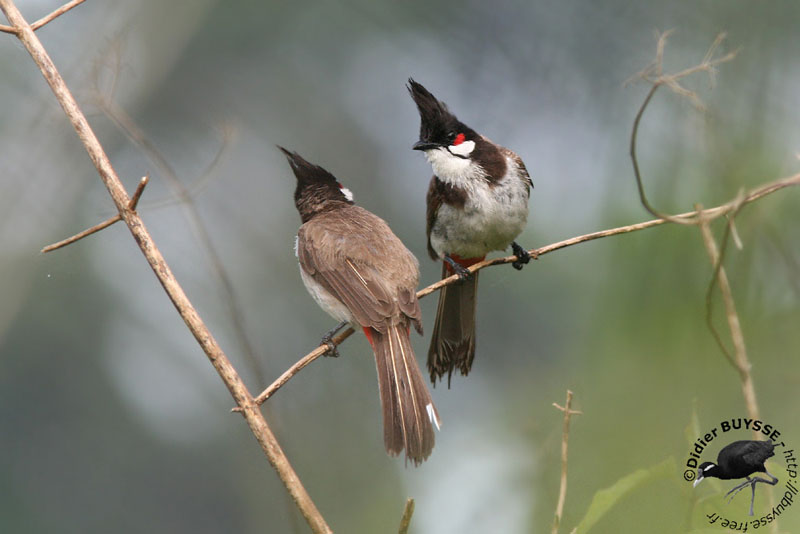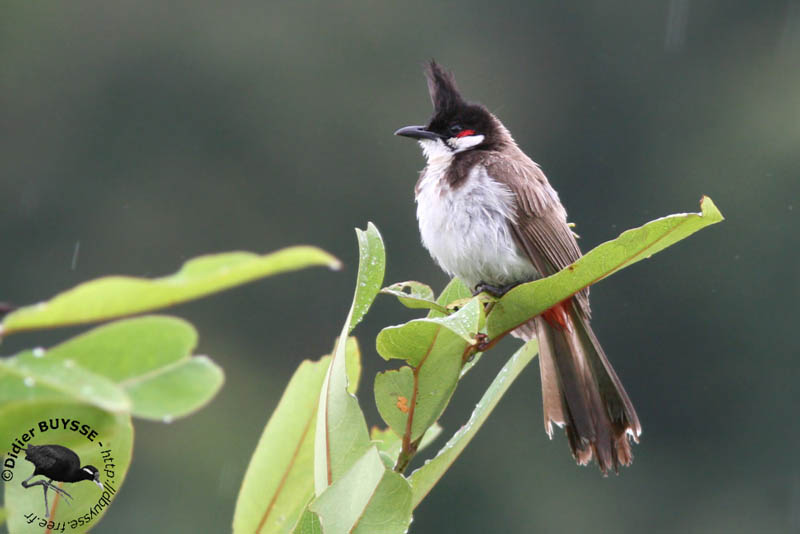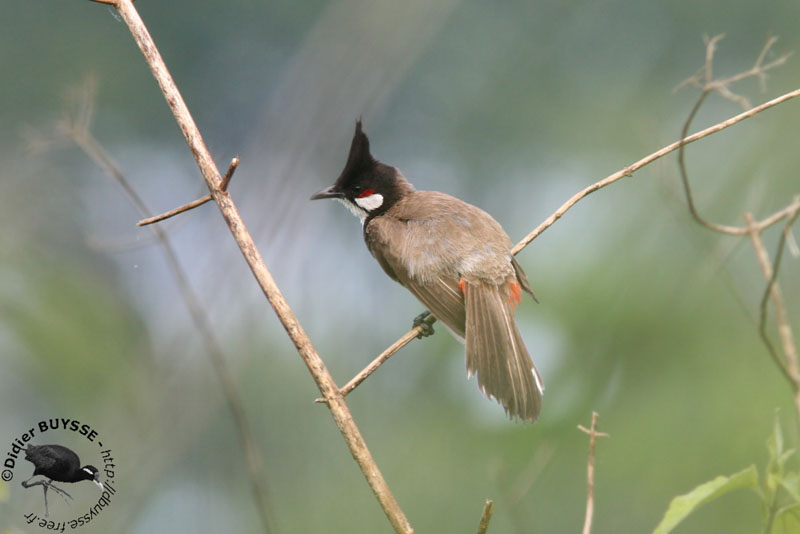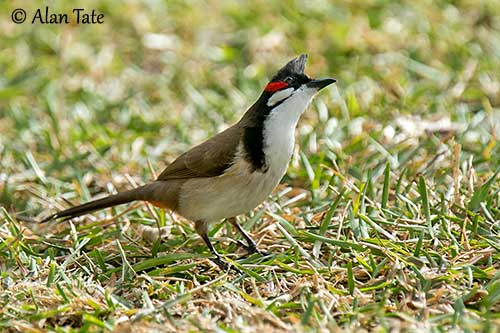
Red-whiskered Bulbul
Pycnonotus jocosus
Passeriforme Order – Picnonotidae Family
BIOMETRICS :
Length: 20-22 cm; Wingspan: 25-28 cm; Weight: 23-42 g
LONGEVITY : up to 4 years
DESCRIPTION:
Red-whiskered Bulbul has grey brown upperparts. Underparts are white. Vent and undertail coverts are bright red.
Head is black and shows a pointed black crest. Cheeks are white, bordered with black moustache. We can see a red patch, called “whiskers”, behind and below the eyes. Nape is black, extending forwards in black half-collar. Chin, throat, chest and belly are white.
Slender bill is black. Eyes are dark brown. Legs and feet are relatively short and black.
In flight, wings appear short and rounded. Long tail varies from rounded to square. The ends of outer tail feathers are white.
Both male and female are similar in plumage.
Juvenile is duller than adults. It lacks the red whiskers and has greyish-black crown.
We can find 8 subspecies, which differ in white tail pattern, black collar, length of crest and bill and back colour.

VOICE: SOUNDS BY XENO-CANTO
Red-whiskered Bulbul is very talkative. It utters short descending musical whistled phrases “witiwet”. We can also hear warbling sounds and noisy chatter. Their deep calls are particularly loud and warm.
HABITAT:
Red-whiskered Bulbul lives in open areas with bushes and scrubs, and second grows. It lives in thickets, near cultivated areas and gardens, and in big towns. It also likes lightly wooded areas. It is resident in its range.
RANGE:
Red-whiskered Bulbul lives in Tropical Asia from Pakistan and India, to southwest Asia and China.
This species has been introduced in Australia (New South Wales), Los Angeles, Mauritius and Florida.
BEHAVIOUR:
Red-whiskered Bulbul is gregarious outside breeding season. It feeds on fruits and buds in gardens, but it also forages on the ground among dense bushes, searching for ants. It also pecks for food on branches, or catches insects while flying. They may gather in large number around a food source. They roost communally.
At dry season, they perform some dispersion, in order to establish nesting territories. Birds perch on top of bushes or on power lines, in exposed places.

During courtship displays, male perches near female, round-shouldered, with widely fanned tail and dangling wings, performing light wing beats. They are monogamous.
Pairs usually remain all year round in their territories. They breed from March to August.
FLIGHT:
Red-whiskered Bulbul performs direct flight with rapid wing beats, but it also has bouncing flight, as a woodpecker.
REPRODUCTION:
Red-whiskered Bulbul’s nest is located in bush, vines, low tree fork, varied supports near habitations, at about 3 to 9 feet above the ground.

Nest is made with dead leaves and twigs, well woven with spider webs. It is lined with fine grasses, rootlets and hair. We can also find paper and plastic, and bark. Nest is an open cup built by both adults.
Female lays 2 to 4 pink-white eggs, spotted with brown. Incubation lasts about 12 to 14 days, shared by both parents. Young are raised and fed by parents. Chicks hatch naked and with closed eyes during several days. They fledge at about 14 to 18 days after hatching. They return to the nest for food during some days, before to become independent.
This species may produce 2 to 3 broods per season.

Fr: Bulbul Orphée
All : Rotohrbülbül
Esp : Bulbul de Bigotes Rojos
Ital : Bulbul dai mustacchi rossi
Nd : Roodoor-buulbuul
Russe : Краснощёкий бульбуль
Sd : Rödörad bulbyl
Photographers:
Didier Buysse
Vision d’Oiseaux
Alan & Ann Tate
AA Bird Photography
Text by Nicole Bouglouan
Sources:
HANDBOOK OF THE BIRDS OF THE WORLD Vol 10 by Josep del Hoyo-Andrew Elliott-David Christie - Lynx Edicions - ISBN: 8487334725
L’ENCYCLOPEDIE MONDIALE DES OISEAUX - Dr Christopher M. Perrins - BORDAS - ISBN: 2040185607
What Bird-The ultimate Bird Guide (Mitchell Waite)
Wikipedia (Wikipedia, The Free Encyclopedia)
Birds in backyards (Birds Australia and Australian Museum)
DIET:
Red-whiskered Bulbul feeds on berries, fruits and insects. It also consumes flower parts, buds and nectar, seedlings and ants.
PROTECTION / THREATS / STATUS:
Red-whiskered Bulbul is common and widespread in its range, and can live near human habitations and in large cities.
